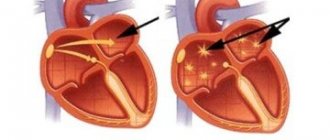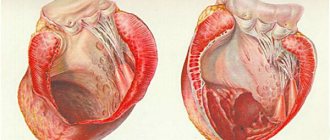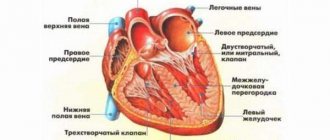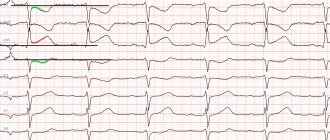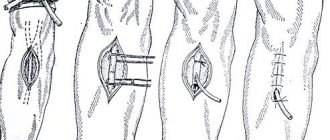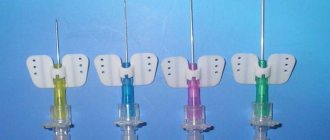Possible complications after cardiac cryoablation
Complications are rare, but no procedure is guaranteed to be risk-free. Before you undergo the procedure, you need to be aware of possible complications, which may include:
- Bleeding;
- Infection;
- Pain at the catheter insertion site;
- Blood clots;
- Injuries to blood vessels and heart;
- Abnormal heart rhythm;
- Heart attack;
- Heart puncture.
Factors that may increase the risk of complications include:
- Smoking
The level of risk may be related to the specific type of arrhythmia.
Cover your heart with ice. The first cardiac operations using cold were performed in Yakutsk
For the first time in Yakutia, a cold treatment method, or cryoablation, was used on patients with arrhythmia. From November 6 to 8, surgeons are performing minimally invasive operations using a unique technology on 12 patients. Read about how low temperatures literally save the hearts of Yakut residents in the YSIA material.
The cryoablation method - literally “cold treatment” - is relatively new for Russian medicine, as it began to be actively used in the country in 2020, and now it has reached Yakutia. From November 6 to 8, Yakut surgeons are performing the first heart surgeries in the history of regional cardiology using low temperatures.
Cryoablation technology involves freezing individual myocardial cells that cause heart rhythm disturbances. Nitrogen gas enters the organ through a special cryoballoon, which is inserted through a catheter, inflated and deflated a few seconds after the procedure.
One operation lasts about 1-1.5 hours under local anesthesia, after which the patient must remain at rest for another day, and after 3-4 days, as a rule, he is discharged from the hospital. Full recovery takes a month.
“Cryotechnology is based on freezing tissue inside the heart, which leads to cell damage and loss of electrical impulses, followed by restoration of a normal, regular rhythm. With this method, the duration of the operation itself, X-ray radiation, and also the time of hospital stay are reduced,” said the surgeon.
According to the deputy director of the Consultative and Diagnostic Center RB No. 1-NTsM Grigory Bugaev , 2% of the entire population of the planet suffers from “flicker”, in other words, atrial fibrillation, characterized by too frequent and chaotic contractions of the heart.
“This is a very large number. Arrhythmia is a pressing issue not only for Yakutia, but for the entire country. Heart rhythm disturbances, which affect the population after 45 years of age, are dangerous due to a higher risk of stroke. The effectiveness of cryoablation in the treatment of this disease is higher than other methods, it is about 90-95%,” he explained.
Previously, in order to undergo surgical intervention, patients suffering from arrhythmia had to be sent to federal centers, added Leonid Pavlov . And now residents of Yakutia will be able to receive the full range of appropriate high-tech medical care within the walls of their own hospital. It is worth saying that the proven method of radiofrequency ablation will also remain in the arsenal of local surgeons, so now the number of quotas for the treatment of arrhythmia should become much larger.
The first patients to survive surgery using cryotechnology were 12 people with atrial fibrillation. The patients were divided into three groups of four people; one of the first to become acquainted with the “coldness in the heart” was Valery Stefansky , who was diagnosed with heart disease as a child.
“Recently, I started to have a “storm”; my blood pressure was high, so when they offered to undergo treatment using a new method, I immediately agreed. The operation was done yesterday, and today I already feel good. Tomorrow I can be discharged,” a happy patient shared with YSIA.
The Yakut cold has acquired a new meaning for all 12 patients, who will return home with a healthy heart in the coming days. By the end of the year, eight more operations with cryoablation will take place; 30 are planned for next year. Watch the YSIA video to see exactly how the unique procedure is performed:
How is cryoablation performed?
Preparation for the procedure
The doctor will likely do the following:
- Electrophysiological examination (cardiac EPS) to accurately determine the location of abnormal rhythms;
- Ask you to stop taking medications that were previously used to treat arrhythmia.
Before the procedure:
- You should not eat or drink anything for eight hours before the procedure;
- Follow your doctor's instructions.
Anesthesia
A local anesthetic will be administered. It will numb the area where the catheter will be inserted. You will also receive a mild sedative through an IV into your arm. This will help you relax during the procedure.
Description of the procedure
A special ablation catheter will be inserted into a blood vessel in the groin, upper thigh, arm, or wrist. The area where the catheter will be inserted will be cleaned and numbed using anesthesia.
The catheter will be inserted into the artery and connected to the blood vessels in the heart. The doctor will be able to see the catheter on the screen of a special X-ray machine.
The doctor finds the source of the arrhythmia. This will be done by identifying the location of the arrhythmia with a special catheter tip. Once the problem area is found, it will be cooled using the tip of the catheter. If the source of the arrhythmia is found correctly, the problem will disappear. If the site is chosen incorrectly, the cold end of the catheter is removed and the tissue will not be damaged in any way.
When the location of the arrhythmia has been correctly identified, the tip of the catheter will be cooled to -70°C. This will freeze the heart tissue and eliminate the arrhythmia. The search procedure is repeated until all sources of arrhythmia are eliminated.
Immediately after the procedure
You will be moved to the recovery room. Staff will monitor vital signs for several hours to look for symptoms of tenderness, heart rhythm problems, or bleeding from the catheter site.
You need to lie on your back for a period of time. A bandage may be placed over the site where the catheter was inserted to prevent bleeding. It is important to follow the directions of your nurse and doctor.
Equipment
Cryoablation is called cryotherapy, or percutaneous ablation. It would be more accurate to call the method cryodestruction, since the effect of sub-zero temperatures is aimed at destroying cancer cells. The peculiarity of the therapy is its low invasiveness. Cryotherapy equipment is a console to which a balloon system, cryoprobe and bronchoscope are connected. The insertion of the cryoprobe is monitored using CT or MRI. An electronic device is built in for automatic dosage calculation.
A cryoprobe is a thin manipulator with one or more needles at the end. A bronchoscope is a thin tube with a video camera and LED attached to the end. The instrument is used to examine the respiratory tract.
For cryotherapy, nitrogen or argon is used. Argon is gentler and its use is approved by the Ministry of Health.
During the procedure, ultrasound and electrocardiography are used, depending on the affected organ.
The cryoablation system is placed in a special room.
The cryoprobe is inserted through the skin or through a surgical incision. Formations on the surface of the skin are also frozen. The procedure is done under local or general anesthesia. Gas is supplied to the cryoprobe. Temperature from -90 to -150 degrees.
Cryoablation procedure
Patient care after cardiac cryoablation
Hospital care
- There may be bruising and pain at the site where the catheter was inserted;
- If the catheter was inserted in the groin area, you need to lie in bed for a while with your legs straight;
- If the catheter was inserted into the wrist or arm, you do not need to stay in bed;
- The catheter insertion site will be monitored for signs of bleeding, swelling, or inflammation;
- Vital parameters will be monitored.
Home care
When you return home after the procedure, follow these steps to ensure a normal recovery:
- Take aspirin as directed for 2 to 4 weeks. This will help reduce the risk of blood clots at the catheter insertion site;
- You can return to normal activities, walking or climbing stairs is allowed. Avoid heavy or physical activity for 24 hours. In most cases, you will be able to return to your normal activity level within a few days;
- It is necessary to make visits to the doctor in a timely manner. Catheter insertion sites should be checked for complications.
This procedure has an extremely high success rate and low risk of complications. However:
- If atrial fibrillation or ventricular tachycardia is present, antiarrhythmic therapy may need to be continued;
- After AV node cryoablation, you will need a pacemaker.
Indications for cryoablation
Often, cryoablation is necessary for patients who have atrial fibrillation (AF). And atrial fibrillation, in turn, is a type of ventricular tachyarrhythmia, characterized by chaotic activity of the atria. Men suffer from this fibrillation more often than the fairer sex.
As the most common type of arrhythmia, atrial fibrillation involves symptoms such as:
- rapid heartbeat and shortness of breath, which worsen with physical exertion;
- feelings of “fading” of the heart;
- dizziness and fainting;
- pain in the chest area;
- increased sweating and general malaise.
And among the causes of AF are ischemia, hyperthyroidism, arterial hypertension, cardiomyopathy, etc.
Contacting your doctor after cardiac cryoablation
After returning home, you should consult a doctor if the following symptoms appear:
- Signs of infection, including fever and chills;
- Redness, swelling, increased pain, bleeding, or discharge at the catheter site;
- The leg into which the catheter was inserted becomes cold, white or blue, numb, or tingling;
- cough, shortness of breath, chest pain, or severe nausea or vomiting;
- Discomfort in the jaw, chest, neck, arm, or upper back;
- Dizziness and weakness.
Advantages of this method
The effectiveness of the procedure has been proven by a large number of successful cases of returning the heart rate to normal. It is fundamentally different from open surgery and has a number of advantages:
good tolerance. Experience shows that patients recover within 3-5 days after RFA. During this time they are in the hospital under the supervision of medical staff. After a conventional operation, the patient will need much more time;- Radiofrequency ablation is a minimally invasive intervention. This means that after it is performed, there will be no noticeable scars or scars left on the body. To carry it out, you need to make a small incision in the thigh area;
- painlessness. The patient may experience mild discomfort in the chest area. After a little time it will pass without the help of painkillers.
In most cases, the procedure is performed once. There is no need to do it again.
